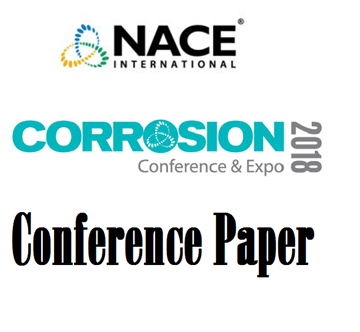- Books
- eBooks
- eCourses
- Standards
-
Conference Papers
- back
- Browse All Conference Papers
- AMPP Conference Papers
-
NACE Conference Papers
- back
- 2020 Conference Papers
- 2019 Conference Papers
- 2018 Conference Papers
- 2017 Conference Papers
- 2016 Conference Papers
- 2015 Conference Papers
- 2014 Conference Papers
- 2013 Conference Papers
- 2012 Conference Papers
- 2011 Conference Papers
- 2010 Conference Papers
- 2009 Conference Papers
- 2008 Conference Papers
- 2007 Conference Papers
- 2006 Conference Papers
- 2005 Conference Papers
- 2004 Conference Papers
- 2003 Conference Papers
- 2002 Conference Papers
- 2001 Conference Papers
- 2000 Conference Papers
- 1999 Conference Papers
- 1998 Conference Papers
- 1997 Conference Papers
- 1996 Conference Papers
- 1995 Conference Papers
- SSPC Conference Papers
- AMPP Branded Apparel
-
Sale
- back
- Clearance
- Books
- eBooks
- eCourses
- Standards
-
Conference Papers
- back
- Browse All Conference Papers
- AMPP Conference Papers
-
NACE Conference Papers
- back
- 2020 Conference Papers
- 2019 Conference Papers
- 2018 Conference Papers
- 2017 Conference Papers
- 2016 Conference Papers
- 2015 Conference Papers
- 2014 Conference Papers
- 2013 Conference Papers
- 2012 Conference Papers
- 2011 Conference Papers
- 2010 Conference Papers
- 2009 Conference Papers
- 2008 Conference Papers
- 2007 Conference Papers
- 2006 Conference Papers
- 2005 Conference Papers
- 2004 Conference Papers
- 2003 Conference Papers
- 2002 Conference Papers
- 2001 Conference Papers
- 2000 Conference Papers
- 1999 Conference Papers
- 1998 Conference Papers
- 1997 Conference Papers
- 1996 Conference Papers
- 1995 Conference Papers
- SSPC Conference Papers
- AMPP Branded Apparel
-
Sale
- back
- Clearance
Corrosion Testing of Additive Manufactured Materials
- Home /
- Conference Papers /
- AMPP Conference Papers /
- Corrosion Testing of Additive Manufactured Materials
51318-10556-Effect of Ferrite and Heat Treatment on the Low Temperature Toughness of Austenitic Castings
We are unable to complete this action. Please try again at a later time.
If this error continues to occur, please contact AMPP Customer Support for assistance.
Error Message:
Please login to use Standards Credits*
* AMPP Members receive Standards Credits in order to redeem eligible Standards and Reports in the Store
You are not a Member.
AMPP Members enjoy many benefits, including Standards Credits which can be used to redeem eligible Standards and Reports in the Store.
You can visit the Membership Page to learn about the benefits of membership.
You have previously purchased this item.
- name of item
Go to Downloadable Products in your AMPP Store profile to find this item.
You do not have sufficient Standards Credits to claim this item.
Click on 'ADD TO CART' to purchase this item.
Your Standards Credit(s)
1
Remaining Credits
0
Please review your transaction.
Click on 'REDEEM' to use your Standards Credits to claim this item.
Your Standards Credit(s)
1
Remaining Credits
You have successfully redeemed:
Go to Downloadable Products in your AMPP Store Profile to find and download this item.
We are unable to complete this action. Please try again at a later time.
If this error continues to occur, please contact AMPP Customer Support for assistance.
Error Message:
Please login to use Standards Credits*
* AMPP Members receive Standards Credits in order to redeem eligible Standards and Reports in the Store
You are not a Member.
AMPP Members enjoy many benefits, including Standards Credits which can be used to redeem eligible Standards and Reports in the Store.
You can visit the Membership Page to learn about the benefits of membership.
You have previously purchased this item.
- name of item
Go to Downloadable Products in your AMPP Store profile to find this item.
You do not have sufficient Standards Credits to claim this item.
Click on 'ADD TO CART' to purchase this item.
Your Standards Credit(s)
1
Remaining Credits
0
Please review your transaction.
Click on 'REDEEM' to use your Standards Credits to claim this item.
Your Standards Credit(s)
1
Remaining Credits
You have successfully redeemed:
Go to Downloadable Products in your AMPP Store Profile to find and download this item.
- Chemicals
- Coatings
- Electric
- Industrial and Potable Water
- Oil and Gas
- Plastic/Composites
- Refinery/Gas Processing
- Storage Tanks
- Buildings and Plant Equipment
- Cathodic Protection
- Chemical Inhibitors
- Coatings and Linings
- Corrosion Monitoring and Control
- Energy Generation
- Highways & Bridges
- Maritime
- Materials Selection and Design
- Military
- Oil and Gas Exploration
- Gas/Liquid Pipelines
- Oil and Gas Production
- Petroleum Refining
- Pipelines, Tanks, and Underground Systems
- Process Industries
- Science of Corrosion
- Test Method
- Water/Wastewater
- 1998 Conference Papers
- 2000 Conference Papers
- 2004 Conference Papers
- 2006 Conference Papers
- 2007 Conference Papers
- 2008 Conference Papers
- 2012 Conference Papers
- 2013 Conference Papers
- 2017 Conference Papers
- 2018 Conference Papers
- ampp annual conference + expo
- ampp conference papers
- coatings
- Conference Papers
- Downloadable


